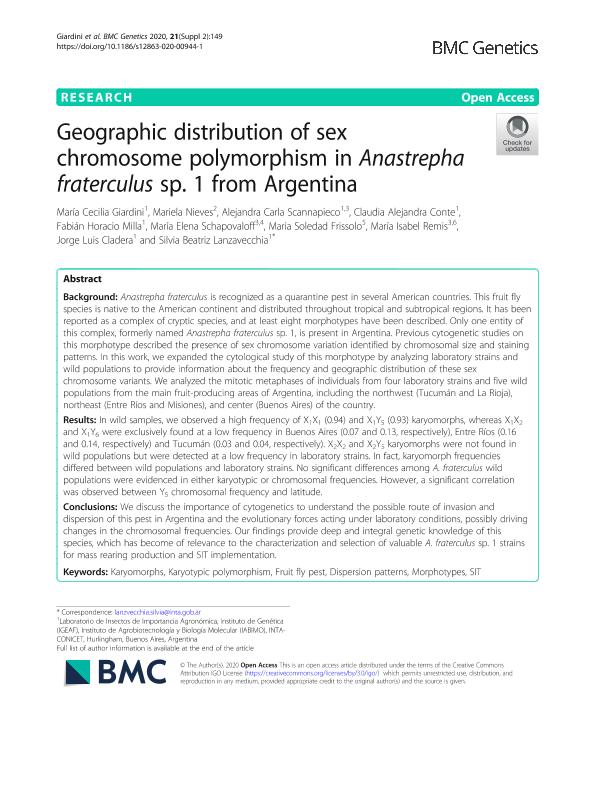Artículo
Geographic distribution of sex chromosome polymorphism in Anastrepha fraterculus sp. 1 from Argentina
Giardini, María Cecilia; Nieves, Mariela ; Scannapieco, Alejandra Carla
; Scannapieco, Alejandra Carla ; Conte, Claudia Alejandra
; Conte, Claudia Alejandra ; Milla, Fabian Horacio; Schapovaloff, María Elena
; Milla, Fabian Horacio; Schapovaloff, María Elena ; Frisolo, Maria S.; Remis, Maria Isabel
; Frisolo, Maria S.; Remis, Maria Isabel ; Cladera, Jorge Luis; Lanzavecchia, Silvia Beatriz
; Cladera, Jorge Luis; Lanzavecchia, Silvia Beatriz
 ; Scannapieco, Alejandra Carla
; Scannapieco, Alejandra Carla ; Conte, Claudia Alejandra
; Conte, Claudia Alejandra ; Milla, Fabian Horacio; Schapovaloff, María Elena
; Milla, Fabian Horacio; Schapovaloff, María Elena ; Frisolo, Maria S.; Remis, Maria Isabel
; Frisolo, Maria S.; Remis, Maria Isabel ; Cladera, Jorge Luis; Lanzavecchia, Silvia Beatriz
; Cladera, Jorge Luis; Lanzavecchia, Silvia Beatriz
Fecha de publicación:
12/2020
Editorial:
BioMed Central
Revista:
BMC Genetics
ISSN:
1471-2156
Idioma:
Inglés
Tipo de recurso:
Artículo publicado
Clasificación temática:
Resumen
Background: Anastrepha fraterculus is recognized as a quarantine pest in several American countries. This fruit fly species is native to the American continent and distributed throughout tropical and subtropical regions. It has been reported as a complex of cryptic species, and at least eight morphotypes have been described. Only one entity of this complex, formerly named Anastrepha fraterculus sp. 1, is present in Argentina. Previous cytogenetic studies on this morphotype described the presence of sex chromosome variation identified by chromosomal size and staining patterns. In this work, we expanded the cytological study of this morphotype by analyzing laboratory strains and wild populations to provide information about the frequency and geographic distribution of these sex chromosome variants. We analyzed the mitotic metaphases of individuals from four laboratory strains and five wild populations from the main fruit-producing areas of Argentina, including the northwest (Tucumán and La Rioja), northeast (Entre Ríos and Misiones), and center (Buenos Aires) of the country. Results: In wild samples, we observed a high frequency of X1X1 (0.94) and X1Y5 (0.93) karyomorphs, whereas X1X2 and X1Y6 were exclusively found at a low frequency in Buenos Aires (0.07 and 0.13, respectively), Entre Ríos (0.16 and 0.14, respectively) and Tucumán (0.03 and 0.04, respectively). X2X2 and X2Y5 karyomorphs were not found in wild populations but were detected at a low frequency in laboratory strains. In fact, karyomorph frequencies differed between wild populations and laboratory strains. No significant differences among A. fraterculus wild populations were evidenced in either karyotypic or chromosomal frequencies. However, a significant correlation was observed between Y5 chromosomal frequency and latitude. Conclusions: We discuss the importance of cytogenetics to understand the possible route of invasion and dispersion of this pest in Argentina and the evolutionary forces acting under laboratory conditions, possibly driving changes in the chromosomal frequencies. Our findings provide deep and integral genetic knowledge of this species, which has become of relevance to the characterization and selection of valuable A. fraterculus sp. 1 strains for mass rearing production and SIT implementation.
Archivos asociados
Licencia
Identificadores
Colecciones
Articulos(CCT - NORDESTE)
Articulos de CTRO.CIENTIFICO TECNOL.CONICET - NORDESTE
Articulos de CTRO.CIENTIFICO TECNOL.CONICET - NORDESTE
Articulos(CEMIC-CONICET)
Articulos de CENTRO DE EDUCACION MEDICA E INVESTIGACIONES CLINICAS "NORBERTO QUIRNO"
Articulos de CENTRO DE EDUCACION MEDICA E INVESTIGACIONES CLINICAS "NORBERTO QUIRNO"
Articulos(IEGEBA)
Articulos de INSTITUTO DE ECOLOGIA, GENETICA Y EVOLUCION DE BS. AS
Articulos de INSTITUTO DE ECOLOGIA, GENETICA Y EVOLUCION DE BS. AS
Citación
Giardini, María Cecilia; Nieves, Mariela; Scannapieco, Alejandra Carla; Conte, Claudia Alejandra; Milla, Fabian Horacio; et al.; Geographic distribution of sex chromosome polymorphism in Anastrepha fraterculus sp. 1 from Argentina; BioMed Central; BMC Genetics; 21; 2; 12-2020; 149-159
Compartir
Altmétricas



